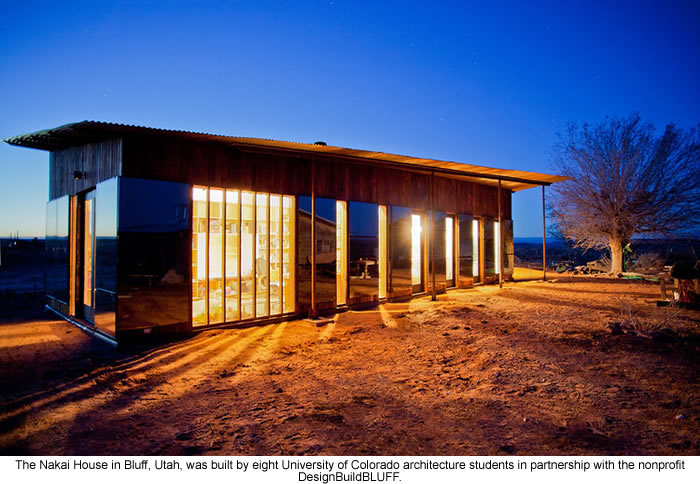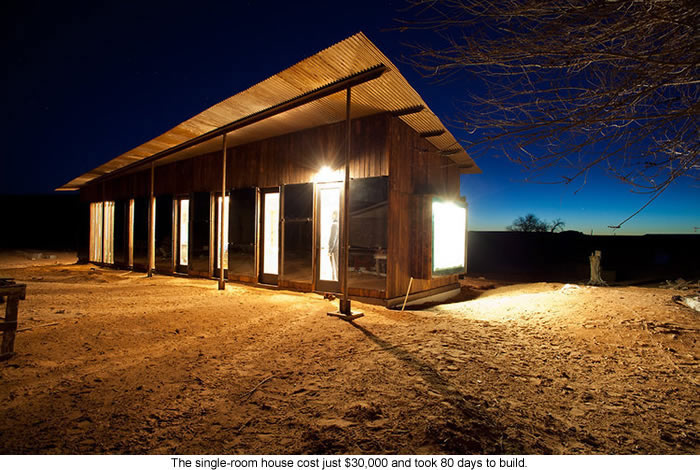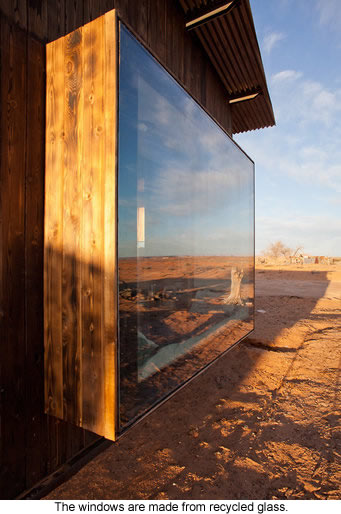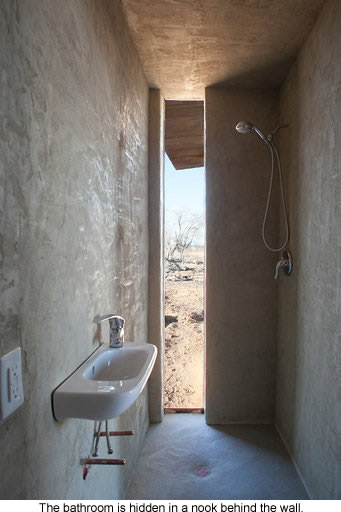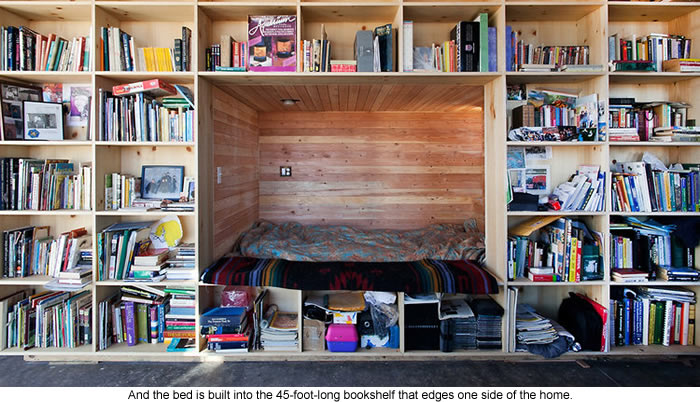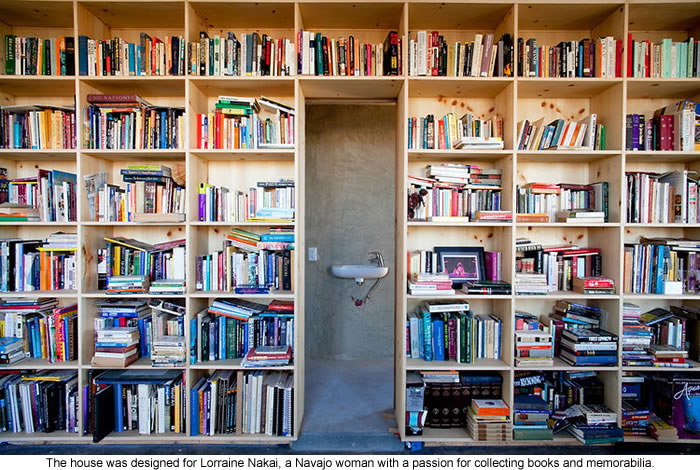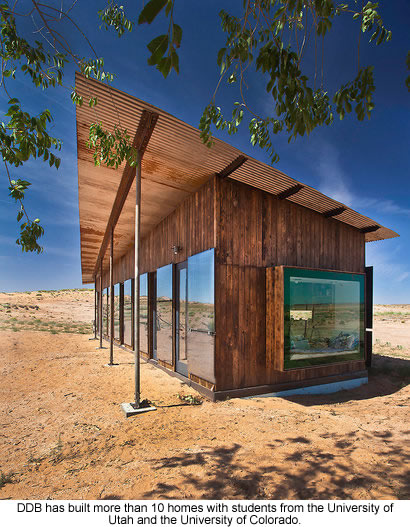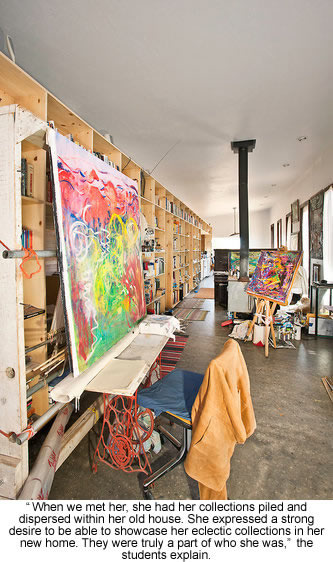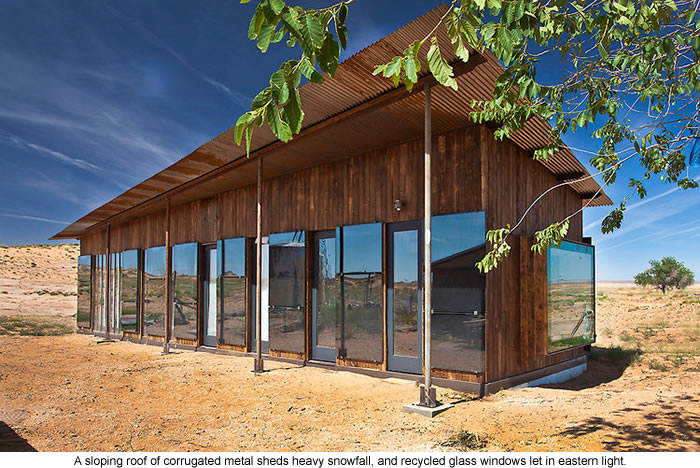 |
Canku Ota
|
 |
|
(Many Paths)
|
||
|
An Online Newsletter
Celebrating Native America
|
||
|
July 2013 - Volume 11
Number 7
|
||
|
|
||
|
Her Hallowed Ground
in the Navajo Nation
|
||
|
by Sarah Amalar - The
New York Times
|
||
|
credits: photos courtesy
of DesignBuildBLUFF
|
|
When a nonprofit group approached Lorraine Nakai in 2011 and offered to build her a house, she was taken by surprise. Although her community activism had improved living conditions for other Navajos on the reservation, it had never occurred to her to seek anything for herself.
"I didn't even know I'd been nominated," she said. "And I was hesitant to be on the receiving end." Eventually, though, she overcame her qualms. And eight months later, Ms. Nakai, a poet and entomologist, settled into a new home at the northern edge of the 27,425-square-mile Navajo Nation, in an area of southeastern Utah her family has inhabited for generations.
Her design and construction crew consisted of eight architecture students participating in a joint venture between the University of Colorado, Denver, and DesignBuildBLUFF, an organization in Bluff, Utah. Founded in 2004 by Hank Louis, a journalist turned architect, the nonprofit group was modeled on Rural Studio, the Alabama-based design-build program, in its emphasis on creative recycling and giving students hands-on experience in an underserved community. As Rick Sommerfeld, the University of Colorado instructor in charge, described it, "It's an immersive program in another culture, like studying abroad in a third-world country, except it happens to be within the United States."
Ms. Nakai, 56, spent much of her childhood here, but like her siblings and two grown children, she left the reservation to pursue an education and career. She was working in entomology on a corporate farm in New Mexico when her grandmother and then her mother died, leaving no one to tend the family homestead, a cluster of small, rundown buildings in the sparsely populated desert. Towering over the flat, windswept site is a water-pumping windmill her parents hauled piece by piece from New Mexico in the 1960s. Whenever Ms. Nakai visited after her mother's death, she would watch the windmill recede in her rearview mirror as she drove away and burst into tears. It represented not just childhood memories, but also her parents' hard-earned investment in water, a precious commodity. She knew she had to move back.
So in 2001, Ms. Nakai relocated to her grandmother's stone cottage and filled it with nearly 2,000 books that she needed to home-school her "gifted and intellectually rambunctious son," she said. (Now 23, he is an emergency medical technician.) By the time the architecture students arrived, the cottage was in such disrepair that renovation would have meant razing it. So they began from scratch a few yards away. Their budget was $25,000 for a 745-square-foot house, with 11 weeks for construction.
Ms. Nakai, who teaches Navajo language, science and math part time at a local school, wanted a flexible space where she could focus on painting, poetry and agricultural research, and could look out on the geological formations she associated with her ancestors. Her stories inspired the long Cor-Ten steel roof that gestures toward a hill she loved climbing as a child and a lone tree that survives from her family's grove. The building materials were mostly salvaged, recycled, donated or obtained cut-rate. A 50-foot-long bookcase runs down the loftlike space. The bathroom is reached through a door tucked into it, and even Ms. Nakai's bed is part of the shelving, a nook she calls "my yacht cabin." Now able to focus on her creative work, Ms. Nakai said the home has grounded her. "This transformation continues to seep in," she added. "It still amazes me that this house is mine."
DesignBuildBLUFF |
||||||
|
|
||
|
|
||
| Canku Ota is a free Newsletter celebrating Native America, its traditions and accomplishments . We do not provide subscriber or visitor names to anyone. Some articles presented in Canku Ota may contain copyright material. We have received appropriate permissions for republishing any articles. Material appearing here is distributed without profit or monetary gain to those who have expressed an interest. This is in accordance with Title 17 U.S.C. Section 107. | ||
|
Canku Ota is a copyright ©
2000 - 2013 of Vicki Williams Barry and Paul Barry.
|
||
 |
 |
|
|
The "Canku
Ota - A Newsletter Celebrating Native America" web site and
its design is the
|
||
|
Copyright ©
1999 - 2013 of Paul C. Barry.
|
||
|
All Rights Reserved.
|
||
